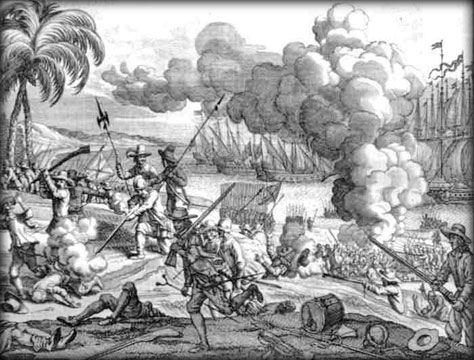The Portuguese and Dutch invasion of Ceylon
By Amal Hewavissenti
Sri Lanka is a country with a proud and remarkable history going back
over 25 centuries. The episodes of Sri Lanka's history of the journey to
independence are replete with events and achievements.
With the Portuguese embarkation on Ceylon (Sri Lankan) shores in
1505, the history opened yet another chapter of battles, chaos and
conspiracy which practically left the country wholly dependent on
Europeans. It was a great opportunity for the Portuguese to capture the
political power of the country when the King of Kotte, Buwanekabahu VII
requested an external succour (from the Portuguese) to safeguard himself
from the kings of Raigama and Sitawaka.
It proved to be a simple task for the Portuguese to capture power
under Don Juan Dharmapala, a weak king the successor to King
Buvanekabahu Warrior Veediya Bandara established a fort at Pelenda in
Pasdun Korale to confront the Portuguese who were by then acquiring
increasing power within the country.
|

Battle against the Portuguese |
Veediya Bandara who had by then empowered himself with adequate
military prowess at Pelenda, was a threat for Mayadunne, the ruler of
Sitawaka. When Mayadunne requested Veediya Bandara's support to
recapture the power of the upcountry, seeds of hostility began to sprout
between them as Veediya Bandara refused his support for Mayadunne.
Thus, both Mayadunne and Portuguese forces united with the single aim
to destroy Veediya Bandara. The Portuguese with Mayadunne's support
invaded Veediya Bandara's fortress at Perenda. Consequently, Veediya
Bandara, on the verge of defeat, withdrew his fighting teams to Jaffna
and joined king Sankily. Later he was killed by the king of Jaffna
because of serious conflicts.
Meanwhile, a warrior called Edirille Rala had secretly organised
troops and empowered himself with a vast military adequate to confront
Portuguese and was killed in 1596.
Danthure and Balana
Danthure battle was a fierce confrontation between the forces of king
Wimaladharmasooriya and the Portuguese. In this historic battle, King
Wimaladharmasooriya vanquished the Portuguese forces and married Dona
Katherina whom once had acted as the secret agent for the Portuguese.
In the wake of repeated defeats at several battles, the Portuguese
chose to implement alternatives to capture the power of the upcountry.
Accordingly Asavedu, the newly appointed commander got down a
supplementary cadre of soldiers from India for the invasion of
upcountry. They succeeded in capturing several fortresses near Balana.
The Sinhala cadre were capable of seizing the Balana fortress after a
pause of a week and Asavedu, with little prospect to save his life, fled
to Colombo.
The battle of Randeniwela
The troops commanded by constantinu De Sae launched a fresh invasion
via Badulla. By that time a strong rapport had been established between
the Sinhalese Mudaliyars of Down South and King Senarath.
The Portuguese power became frail owning to the large scale
dispersion and flight of their troops in the face of fierce attacks by
the Sinhalese soldiers.
Ultimately the Portuguese captain was killed by upcountry civilians
at Randeniwela near Wellawaya.
Battle of Gannoruwa
Following the demise of King Senarath, his son, Rajasinghe II became
the successor to the throne and launched negotiations with the Dutch to
subdue Portuguese power.
The Portuguese in complete knowledge of this plan attempted to
capture the upcountry before the arrival of Dutch in Ceylon. The troops
commanded by General Diego de Velo plundered and set fire to the city.
Meanwhile, the Indian soldiers joined king Rajasinghe's troops and
subsequently there came a fatal warfare at Gannoruwa between the two
parties in 1638. This was recorded as the final battle fought between
the Sinhalese and the Portuguese. The purpose of bringing the Dutch to
the country was to ostracise Portuguese and to recapture the control of
areas which were dominated by the invaders.
Since conventions between the Dutch and the Sinhalese king appeared
to be trustworthy, both parties signed an accord in May 1638.
Although the king offered the dominance of the cinnamon trade to the
Dutch, they were far less satisfied with it and they wanted to seize the
power of areas occupied earlier by the Portuguese.
After several strategies, the Portuguese were finally repelled from
the island but the Dutch appeared to redouble the threat posed by the
Portuguese.
Here the Dutch tried to establish their authority down south. The
Dutch and the Sinhalese were in frequent battles to capture the coastal
areas earlier possessed by the Portuguese.
When the king faced challenges with the Dutch rulers, he desperately
sought assistance from the British to curb the domination of Dutch
rulers.
When the Dutch governor forwarded a document with conditions which
the king could hardly comply with, the Dutch declared war against the
king. Dutch platoons commenced their expedition to Kandy but
unfortunately they were stranded midway.
Gaining the advantage, the king's troops attacked Dutch at the right
time.
Thus, the attempt of the Dutch to invade the upcountry lamentably
failed in 1764. The negotiations between the British and the king
produced good results but the areas which had been under Dutch
supervision were captured by British East India Trading Company in
February 1797. |

